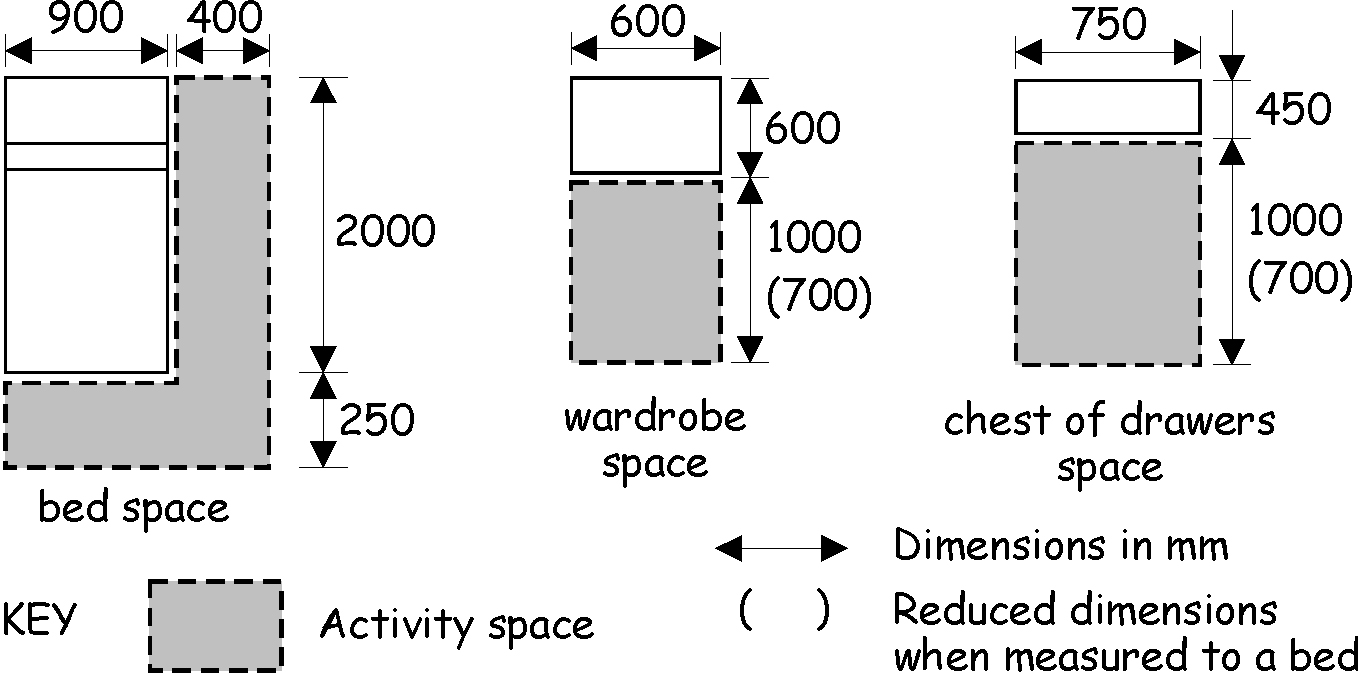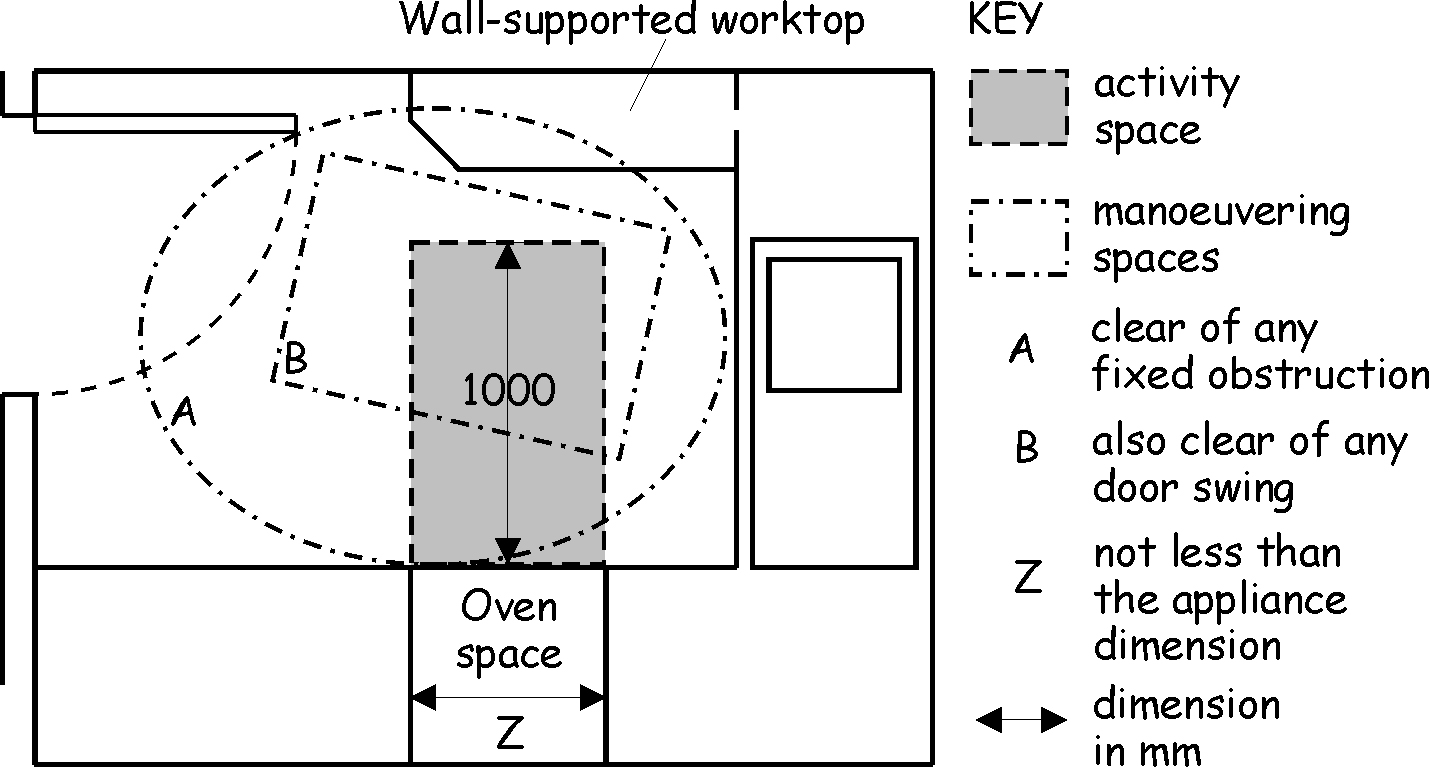3.11 Facilities in dwellings
|
Guidance on design of dwellings recommends that the size of individual rooms should be dictated by the way a room should function and the activities that are to be accommodated rather than by arbitrary rule of thumb areas. This design philosophy was included in a report by Sir Parker Morris in the 1960s and is still relevant today.
Extending standards to address ‘liveability’ and the needs of occupants supports the Scottish Government’s aim of promoting a more inclusive built environment and will better address the changing needs of occupants over time. This approach to the design of dwellings ensures that Scotland's housing stock can respond to the needs of our population, now and in the future.
The provision, on one level, of an enhanced apartment, and kitchen under this standard, together with accessible sanitary accommodation (Standard 3.12) and improvement to circulation spaces (Standard 4.2) will assist in creating more sustainable homes.
The guidance in this standard and Standard 3.12, together with the guidance in Section 4, Safety relating to accessibility, has been based around, and developed from, issues that are included in ‘Housing for Varying Needs’ and the Lifetime Homes concept developed by the Joseph Rowntree Foundation.
Drying of washing - from 1963 to 1986 the building regulations included a requirement for the provision of drying facilities. This was removed in response to increased ownership of specialised appliances and the vandalism of common drying areas in blocks of flats. The re-introduction of space to allow washing to be dried other than by a tumble drier is intended to encourage the use of more sustainable methods and thereby reduce carbon dioxide emissions.
Recycling - designers should be aware of local authority initiatives on the recycling of solid waste and useful cross-references are provided in the guidance to Standard 3.25, Solid waste storage. Such initiatives may affect storage provision in a dwelling.
Conversions - in the case of conversions, as specified in regulation 4, the buildings as converted shall meet the requirement of this standard (regulation 12, schedule 6).
Every apartment should be of a size that will accommodate at least a bed, a wardrobe and a chest of drawers, this being the minimum furniture provision that may be expected in such a room. Associated activity spaces for each item of furniture should be shown as in the diagram below. A door swing may open across an activity space.
Additional information:
Activity spaces for furniture may overlap.
A built-in wardrobe space of equal size may be provided as an option to a wardrobe.
Smaller apartments or those with an unusual shape may limit how space within can be used. Where all apartments within a dwelling are designed in this way, this will present problems for occupants, particularly if affecting the main living spaces.
Therefore, at least one apartment on the principal living level of a dwelling should be of a size and form that allows greater flexibility of use. This enhanced apartment should:
have a floor area of at least 12m2 and a length and width at least 3.0m (see Note 1). This area should exclude any space less than 1.8m in height and any portion of the room designated as a kitchen, and
contain a unobstructed manoeuvring space of at least a 1.5m by 1.5m square or an ellipse of at least 1.4m by 1.8m, which may overlap with activity spaces recommended in clause 3.11.1. A door may open over this space, and
have unobstructed access, at least 800mm wide, to the controls of any openable window or any heating appliance and between doors within the apartment.
Note 1: In some small dwellings (i.e. those with not more than 3 apartments) it may not always be reasonably practicable to achieve the minimum length or width of 3m. In such one or two bedroom properties, either the length or the width may be reduced to not less than 2.8m, however, a floor area of at least 12m2 should be maintained.
A dwelling should have a kitchen and, to be accessible, this should be on the principal living level. Space should be provided within the kitchen to both assist in use by a person with mobility impairment and offer flexibility in future alteration.
The layout should include an unobstructed manoeuvring space of at least a 1.5m by 1.5m square or an ellipse of 1.4m by 1.8m. A door may open across this manoeuvring space but a clear space of at least 1.1m long by 800mm wide, oriented in the direction of entry into the room, should remain unobstructed, to allow an occupant to enter and close the door.
A wall-supported worktop or similar obstruction, the underside of which is at least 750mm above floor level, may overlap the manoeuvring space by not more than 300mm.
Where a kitchen is within the same room as an apartment, the area of the kitchen should be defined by a rectangle enclosing any floor-standing units, appliances and worktops. In such cases, manoeuvring space for the kitchen may project into the apartment but should not overlap with the separate manoeuvring space of an enhanced apartment.
A kitchen should be provided with space for a gas, electric or oil cooker or with a solid fuel cooker designed for continuous burning. The space should accommodate such piping, cables or other apparatus as will allow the appliance to operate. A cooker should have an activity space to allow access to, and safe use of, an oven, as shown in the diagram above. An activity space need not be provided in front of a hob or microwave oven.
Kitchen storage of at least 1m3 should be provided either within or adjacent to the kitchen. Additional storage may be required depending on the local authority’s recycling policy.
Reduced headroom, such as beneath a sloping ceiling, can cause problems in use of both facilities and furniture, particularly if a person has difficulty in bending or has a visual impairment.
Activity spaces within the enhanced apartment or kitchen should therefore have an unobstructed height of at least 1.8m.
Where works to alter or extend are proposed, physical constraints in the size of an extension or the form of an existing building may mean that meeting recommendations in guidance is not always possible. Accordingly:
where alteration or extension of a building includes works to, or provision of a new, apartment on the principal living level of the dwelling, and there is not already an enhanced apartment on that level, guidance in clause 3.11.2 should be met as far as is reasonably practicable
where altering an existing kitchen, guidance on manoeuvring space given in clause 3.11.3 should be met as far as is reasonably practicable.
Drying washing indoors can produce large amounts of water vapour that needs to be removed before it can damage the building fabric or generate mould growth that can be a risk to the health of occupants. The tendency to build ‘tighter’ buildings could increase these risks by trapping the moisture in the building. Providing dedicated drying areas either outside or inside the dwelling should discourage householders from using non-sustainable methods of drying washing and should encourage the adoption of alternative practices that limit the production of greenhouse gases and the depletion of material resources.
Outdoor drying space - drying washing outside will avoid the problems of high relative humidity in the home and where it is reasonably practicable, an accessible space for the drying of washing should be provided for every house on ground immediately adjacent to, and in the same occupation as, the house. The area provided should allow space for at least 1.7m of clothes line per apartment.
Indoor drying space - since weather is unreliable in Scotland, a designated space for the drying of washing should be provided in every dwelling, in addition to the external space.
The designated space may be either:
capable of allowing a wall mounted appliance which may, for example be fixed over a bath, or
capable of allowing a ceiling-mounted pulley arrangement, or
a floor space in the dwelling on which to set out a clothes horse.
The designated space should have a volume of at least 1m3 and should have no dimension less than 700mm. The designated space should allow space for at least 1.7m of clothes line per apartment.
The location of the designated space should not restrict access to any other area or appliance within the dwelling nor obstruct the swing of any door.
Guidance to Standard 3.14 provides information on the ventilation of indoor spaces designated for the drying of washing.

